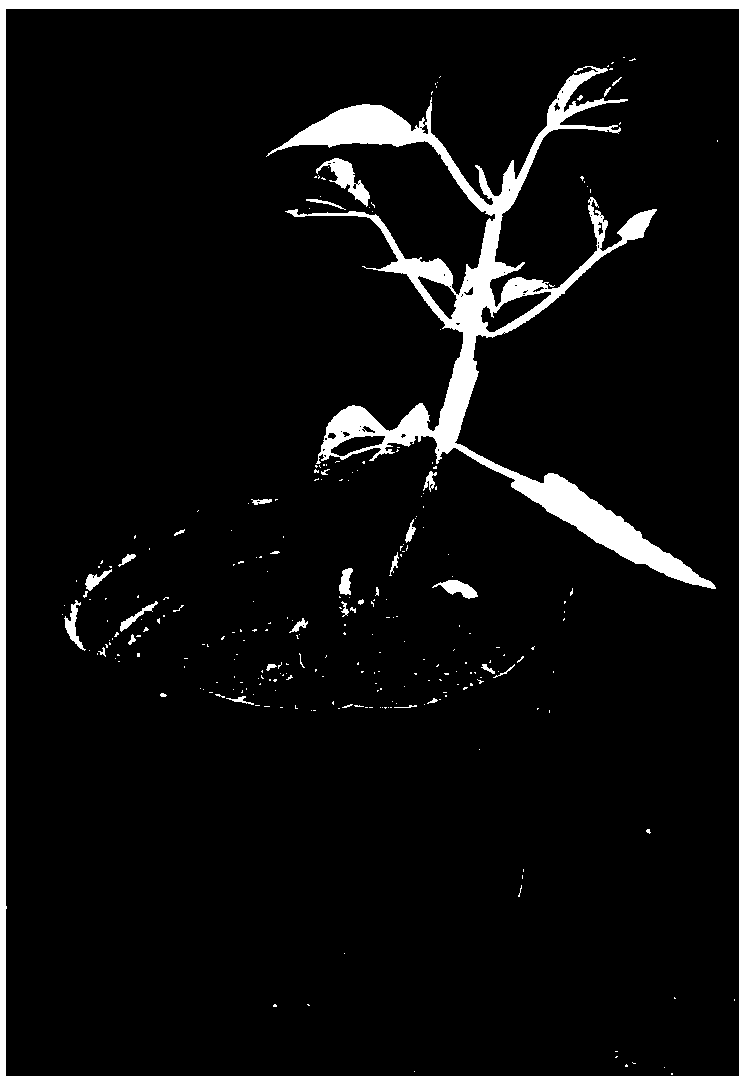Grafting method of flower plant salvia splendens
A plant and flower technology, which is applied in the field of grafting of flowers and plants, and vermilion lip, can solve the problems of low plant tissue affinity, slow wound healing, and low graft survival rate, and achieves strong photosynthesis ability and accelerated growth rate. , Improve the effect of grafting survival rate
- Summary
- Abstract
- Description
- Claims
- Application Information
AI Technical Summary
Problems solved by technology
Method used
Image
Examples
Embodiment 1
[0069] 1. Preparation of rootstock and scion materials
[0070] In the same period, sow vermilion seeds and a bunch of red seeds in different hole trays, and cover the surface of the substrate with vermiculite, in which peat and sand are mixed at a volume ratio of 1:1 as the cultivation substrate, and then cover the holes with plastic film Moisturize the tray; change the pot when there are 2 to 3 pairs of true leaves (the purpose is to promote the growth of the root system, which can better promote the overall growth of the plant), and pay attention to water and fertilizer management (water the 'Christmas tree' dissolved in a ratio of 1:1000 once a week Water-soluble compound fertilizer), grafting will be carried out when Zhulip and Yichuanhong change pots to 5-6 pairs of true leaves.
[0071] After changing the pot, Zhulip can be used as a rootstock for grafting when it grows to 5-6 pairs of true leaves, because after removing the top 2 nodes, 3-4 nodes can be left as rootsto...
Embodiment 2
[0091] 1. Preparation of rootstock and scion materials
[0092] Same as Example 1.
[0093] 2. Preparation of rootstock material
[0094] Except that step 2A) retains the bottom 4 joints of the stem section of the vermilion lip plant as rootstock, all the other are the same as in Example 1.
[0095] 3. Preparation of scion materials
[0096]3A, select seedling stage, have a bunch of red strong plants of 5~6 pairs of true leaves, cut and keep the top tender stems of 3 nodes, and the distance from the functional leaves of the 3rd nodes is the top tender stems of 2.5cm as the scion, Then cut and remove part of the functional leaves, the area of the retained functional leaves is 1 / 2 (usually 1 / 3 to 2 / 3, preferably 1 / 2) of the original functional area, that is, to cut and remove half of the functional leaves. That is to cut off half of the functional leaf area;
[0097] 3B, cut the stem portion into a wedge-shaped length of 1.0cm at the bottom 1.5cm place of the bottom pair o...
Embodiment 3
[0104] 1. Preparation of rootstock and scion materials
[0105] Same as Example 1.
[0106] 2. Preparation of rootstock material
[0107] Except that step 2A) retains the bottom 3 joints of the stem section of the vermilion lip plant as a stock, and splits the stock stem section upper end vertically, except that the depth is 0.7cm, all the other are the same as in Example 1.
[0108] 3. Preparation of scion materials
[0109] 3A, select seedling stage, have 5~6 pairs of true leaves of a bunch of red robust plants, cut and keep the top tender stems of 2 nodes, and the top tender stems with a distance of 2.0cm from the functional leaves of the second node are used as scions, Then cut and remove part of the functional leaves, the area of the retained functional leaves is 1 / 2 (usually 1 / 3 to 2 / 3, preferably 1 / 2) of the original functional area, that is, to cut and remove half of the functional leaves. That is to cut off half of the functional leaf area;
[0110] 3B, cut the ...
PUM
 Login to View More
Login to View More Abstract
Description
Claims
Application Information
 Login to View More
Login to View More - Generate Ideas
- Intellectual Property
- Life Sciences
- Materials
- Tech Scout
- Unparalleled Data Quality
- Higher Quality Content
- 60% Fewer Hallucinations
Browse by: Latest US Patents, China's latest patents, Technical Efficacy Thesaurus, Application Domain, Technology Topic, Popular Technical Reports.
© 2025 PatSnap. All rights reserved.Legal|Privacy policy|Modern Slavery Act Transparency Statement|Sitemap|About US| Contact US: help@patsnap.com



